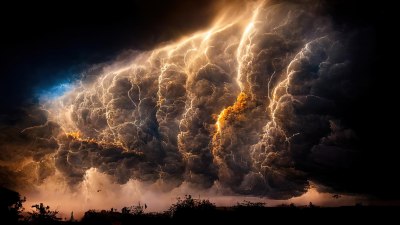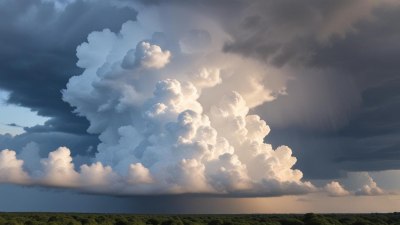How Climate Change Is Fueling Megastorms You’ve Never Seen Before
Explore the impact of climate change on megastorms and their growing intensity and frequency.

Image by yanademenishin on Freepik
In recent years, the world has seen an alarming increase in the frequency, intensity, and destructive power of megastorms, phenomena that seem to defy explanation and challenge our understanding of natural weather patterns. As climate change progresses, the dynamics of these storms are evolving at an unprecedented rate, making them more potent and frightening. This article delves into how climate change is fueling megastorms you’ve never seen before, exploring their causes, impacts, and what we can expect in the future.
Understanding Megastorms
Megastorms are characterized by their extreme weather conditions, which can include heavy rainfall, hurricane-force winds, and widespread flooding. These storms are larger in scale and intensity compared to typical storms, often spanning hundreds of miles and affecting millions of people. Examples of such storms include hurricanes, typhoons, and severe thunderstorms, all of which have shown a significant increase in strength and duration. The growing evidence suggests that climate change is a major driver behind these extraordinary forces of nature.
The Science Behind Climate Change and Storm Intensification
As global temperatures rise due to greenhouse gas emissions, the atmosphere warms, which has profound implications for weather patterns. Warmer air holds more moisture, which can lead to more intense precipitation events. A warmer ocean also contributes to stronger hurricanes, as tropical storms derive their energy from warm ocean waters. The increasing surface temperatures in the oceans, caused mainly by climate change, provide the perfect breeding ground for these powerful storms, increasing their potential for devastation.
Human Influence: A Contributing Factor
Human activities, primarily the burning of fossil fuels and deforestation, have accelerated climate change. As we release carbon dioxide and other greenhouse gases into the atmosphere, we enhance the greenhouse effect, leading to global warming. This increase in temperature directly correlates with the intensity of storms. A study conducted by climate scientists found that every degree Celsius of warming can lead to a 7% increase in rainfall, a factor that heavily influences the severity of precipitation during storms.
Case Studies of Recent Megastorms
To illustrate the alarming trend of climate change-fueled megastorms, consider the following case studies. In 2020, Hurricane Laura made landfall in Louisiana as a Category 4 storm, causing widespread destruction. The hurricane’s intensity was attributed to the unusually warm waters of the Gulf of Mexico. Similarly, Typhoon Goni, which struck the Philippines the same year, became one of the strongest typhoons to ever make landfall, with wind speeds surpassing 200 mph. These events reflect a disturbing trend: as climate change continues, we can expect storms to become increasingly more severe.
Impact on Communities
The impact of megastorms on communities is profound. Urban areas are particularly vulnerable, as heavy rainfall can lead to widespread flooding and property damage. Critical infrastructure, such as roads, bridges, and power lines, can be severely compromised, leading to long-term economic consequences for affected regions. Additionally, the psychological toll on communities and individuals cannot be overstated. Flooding and destruction disrupt everyday life, leading to displacement and loss of community cohesion.
The Role of Preparedness and Adaptation
With the increasing threat of megastorms, preparedness and adaptation are crucial. Communities must invest in resilient infrastructure capable of withstanding extreme weather events. This includes improving drainage systems to prevent flooding, reinforcing buildings to withstand high winds, and creating emergency response plans. Moreover, educating locals about the risks associated with climate change and megastorms is vital in fostering a culture of preparedness.
Looking Ahead: Future Projections
As we look to the future, the projections are concerning. Climate models indicate that, without significant intervention, we can expect an increase in the frequency and intensity of megastorms. By 2050, it is projected that we could see a 10-20% increase in the strength of cyclones and hurricanes, increasing the risks associated with these storms. Understanding these projections is crucial for thinking strategically about how to reduce the impact of climate change.
Global Responses to Climate Change
Addressing the root causes of climate change demands a global effort. International agreements, such as the Paris Agreement, aim to limit global warming and its associated risks, including the intensification of storms. Countries worldwide are encouraged to reduce greenhouse gas emissions and invest in renewable energy sources. However, individual nations must also focus on their specific vulnerabilities to megastorms and climate change as they develop targeted strategies.
The Importance of Climate Science
Climate science plays a crucial role in understanding the relationship between climate change and the increasing intensity of megastorms. Continuous research helps climatologists and meteorologists better predict storm patterns, identify affected regions, and develop early warning systems. As our understanding of climate change grows, so does our ability to mitigate its effects and protect vulnerable communities.
As climate change continues to reshape our planet, the rise of megastorms represents a significant challenge that demands urgent attention. The science is clear: human-induced climate change is intensifying storms, resulting in catastrophic consequences for communities around the world. By understanding the dynamics of these powerful weather events and adopting comprehensive strategies to mitigate climate change, we can prepare for the future while striving to protect our environment and the people who inhabit it.











